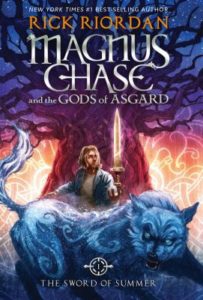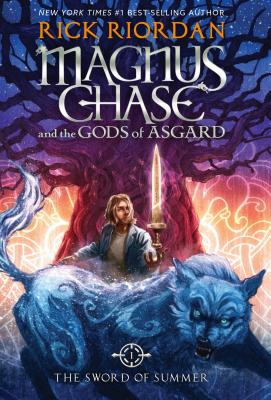craft review by Jen Jobart

Magnus Chase and the Gods of Asgard, Book 1: The Sword of Summer, by Rick Riordan (Disney-Hyperion, 2015)
The first in the MAGNUS CHASE series, like most of Rick Riordan’s books, has been a huge success. It has spent months at the top of the New York Times middle grade bestseller list. Personally, it is my own kids’ favorite book, and I credit Rick Riordan’s books in general with motivating them to become avid readers.
As a writing-focused book discussion group, we were interested in reading this book because we wanted to explore the question about whether we are writing for the kids who will read our books, or for the parents and publishers who will buy our books.
Many kids unconditionally love this book. As adults, though, we had some questions. It breaks many of the rules that we’ve learned as writers. The character arcs are minor, at best. The book is far longer than is usually considered optimal. The plot arc is there, but buried. But despite all of that, this book is indisputably a huge success, and we wanted to explore what makes it work so well.
He keeps the action happening
From the very beginning, kids are breathlessly caught up in the action, wanting to know what happens next. The book actually reads like a video game, with one battle or action scene following another, all connected in the guise of a larger quest. My kids have read it several times from front to back, the normal way, but they’re also apt to pick it up and read whatever scene the book opens to. Lots of kids seem to gravitate toward Riordan’s style of writing in short bursts of action.
Action: These days, books don’t just compete for attention with other books on the shelf. Kids are also tempted by TV, movies, and video games, not to mention all of the homework and extracurricular activities that take up so much of their time. Look critically at each scene to make sure it is as entertaining as possible. If you want to keep kids turning pages, keep the action happening.
He hooks kids with humor
Riordan’s deliciously sarcastic sense of humor dominates the book, and resonates so well with his middle-grade target audience. Take this paragraph, for example:
“Charging up the bridge came my buddies Blitz and Hearth. Well… I say charging. That implies it was impressive. It really wasn’t. For some reason, Blitz had donned a broad-brimmed hat and sunglasses along with his black trench coat, so he looked like a grungy, very short Italian priest. In his gloved hands he wielded a fearsome wooden dowel with a bright yellow traffic sign that read: MAKE WAY FOR DUCKLINGS.”
I played the Audible version of this book while driving a group of elementary aged boys on a field trip, and this paragraph had the whole car cracking up. It is no small feat to get boys to shed their inhibitions and laugh with one another, and Riordan accomplishes it with aplomb.
Action: Not everyone has Rick Riordan’s sense of humor, but we all have our own unique sense of humor. Tap into your funny bone, and use it to connect with kids.
He doesn’t shy away from diversity
We don’t live in a world composed exclusively of white males, so it doesn’t make sense to write books that have all white male characters. There is a lot of discussion and debate about this right now in the field of children’s literature, and the #WeNeedDiverseBooks movement is at the heart of these discussions. As writers, we are placed in a conundrum – do we dare to write about characters who don’t share our own physical characteristics and life journeys, and risk getting it wrong, or do we take the safe road, but leave out the vast majority of kids who don’t identify with our characters? There are no easy answers.
Riordan boldly steps forth and writes about characters of all types. One of the main characters in his book, Samirah al-Abbas, is a hijab-wearing Muslim girl. She is a strong match for Magnus, the main character. I admire and respect Riordan for honoring his readers by daring to write about characters that are unlike himself, and as a white female, my uneducated opinion is that he does it well.
Action: There are no right answers for how to approach this dilemma. As writers, we do need to think carefully about where we stand, deliberately making decisions about how we will approach diversity in our own books, and being prepared to stand by our decisions once our books are in the market.
He sneaks in information
Riordan taught middle school English and history, and his writing makes it clear that he is gifted at making factual information entertaining. By the end of the book, readers realize that they have inadvertently acquired a fairly detailed understanding of Norse mythology. Many of Riordan’s books are like that. It’s quite a feat to keep kids so hooked on books that are, at their core, educational in nature.
Action: Every reader learns something from every book. It’s not always (or even often) academic in nature, but humans are naturally curious, and our desire to learn is one of the things that keeps us reading. Whether your book imparts factual information, or a philosophical theme that helps a child grow as a person, step back and think about whether your book strikes the right balance of being informational without being preachy.
Jen Jobart writes middle grade fiction and is always sending characters she loves on dangerous adventures. She is an active member of the SCBWI and has studied writing for children through Stanford’s Continuing Studies program. When Jen’s not writing, she’s outside gardening and raising chickens at her home in the San Francisco Bay Area. Find her at www.jenjobart.com.


Thanks for the informative article, Jen. I didn’t care much for Riordan’s post-Percy Jackson books, but you’ve piqued my interest in his gods of Asgard series.
I am yet to pick up Magnus Chase. I have been meaning to. I do really like how he does sneak in the information. Learning to write action like him has been an interesting process.
Hey Sam PC, I like how he sneaks in information, too. My kids are currently into the books from his imprint and learning a lot, plus they’re enjoying the books. What kinds of things are you doing to learn to write action like him?